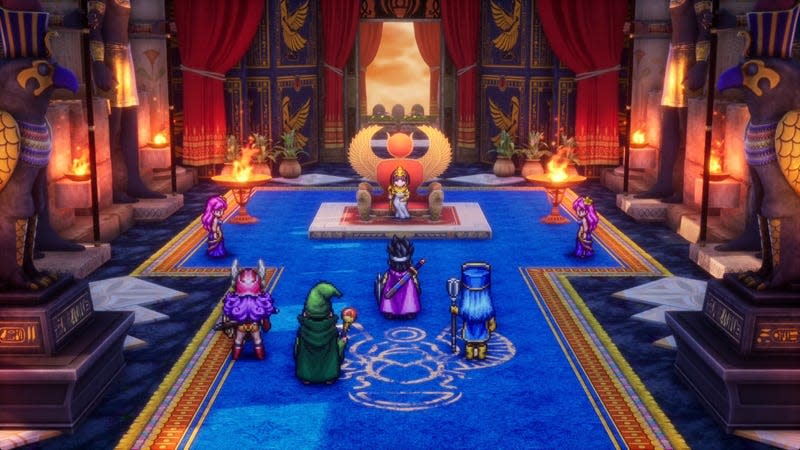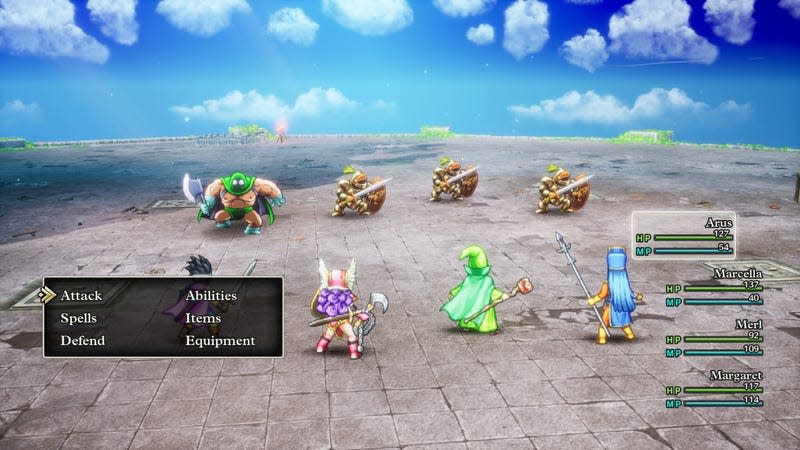Dragon Quest 3 Remake Hands-On: A Classic RPG Gets A Stunning Overhaul

I don’t have the wealth of history with classic RPGs that many of my peers and colleagues do. Many of them came up with the franchises that we now view as seminal texts, such as Chrono Trigger and Dragon Quest, but I missed out on these as a kid. Chalk it up to disinterest or relative poverty, but those games were never quite my bag. Nowadays though, I’m infatuated with the genre, and not only am I trying to take in everything happening right now, but I’m desperately trying to fill in the gaps of the past. Dragon Quest 3’s upcoming HD-2D remake seems like a ripe opportunity to address the latter.
I recently got the opportunity to go hands-on with an early stretch of Dragon Quest 3 HD-2D Remake and, while I’m not one to comment on its faithfulness to the original, I am happy to say that it feels like a classic through and through. It isn’t without modernizations and quality-of-life tweaks that’ll enrich the experience for a new audience, but it sure as hell still feels like the genuine article.
Dragon Quest 3 seems like the natural first choice for the “HD-2D” remake treatment of the beloved JRPG series since it marks the chronological start. The hero’s father, a legendary warrior in his own right, embarks on a quest to slay the all-powerful Beramos, but never makes it back. Eventually, the responsibility for completing this quest falls on his child, the playable hero of Dragon Quest 3, and thus does the journey begin.
With this in mind, Square Enix dropped a handful of us into the early hours of the game—quite literally at level 1—as we made our way to the town of Reeve. It was a simple and short quest, but it was more than enough to give me a proper sampling of Dragon Quest 3. I was left wanting more.
One thing that immediately stood out to me was how immediately challenging Dragon Quest 3’s combat was and how tactical it called for me to be. I’m used to having my hand held for the opening hours of basically any game, but especially an RPG. Dragon Quest 3 eschews that, which feels right, as games rarely had that tendency back in 1988. Instead, I was immediately dropped onto a pretty but barren overworld replete with monster encounters that often had me threading a very careful line.
Whether it was due to my party’s relatively low MP count or a lack of any real equipment, I was forced to be tactical and precise in battle with an immediacy that’s kind of rare to find. I appreciated how Dragon Quest 3 didn’t treat me like I was some novice, and because of that I felt like I was forced to become a better player early on. One of my characters was a designated tank and the second they began leveling up, I started utilizing their damage-absorbing abilities more than their range of attacks. One technique pulled all aggro toward them and another deflected enemy damage onto other enemies or allies. This came in clutch at certain points in a dungeon after my main damage-dealing unit barely survived a few encounters in a row, and just needed to make it to a health-restoring level-up.

In other cases, I really relished using my mage’s incredible “poof” skill, which literally makes enemies disappear. The tradeoff there was that I got fewer morsels of XP, but once again, it felt great to leverage a slew of different skills to carefully dispatch occasionally overwhelming odds. The early hours of an RPG can often be a bit dry as your characters grow in strength and eventually become distinct players on the field, but Dragon Quest 3 starts there, and I can only imagine where it ends.
Though the scenario I played through was hardly complex or noteworthy, it was a proper showcase of the HD-2D treatment that Dragon Quest 3 is receiving, and that Square Enix has pioneered. I’ve had complicated feelings about the visual style in the past, where it sometimes felt like it struggled to bring anything new to a game, but here it finally felt appropriate and looks gorgeous. At least in this remake of Dragon Quest 3, the dioramic art style feels like a way to enshrine the legacy of this legendary title and prominently display it. According to the presentation we were treated to before our demo, the upgraded visual style also allowed the developers to better portray the range of destinations in Dragon Quest 3, which could only be represented in pixels before. Now, the team can represent the game’s various locales in ways that more effectively reflect the real places Dragon Quest 3 takes influence from.
For all its faithfulness to the spirit of the original, Dragon Quest 3 HD-2D Remake does boast many of the optimizations that you might come to expect from a port or a remake of a classic RPG. Toggleable battle speeds are among the most important changes in this remake because, gosh, is that game slow as hell otherwise. You can also set the party members outside of the Hero to automatically battle on their own if you would rather focus on one character, but that just feels wrong in any RPG I play so I never bother with that setting.
My time with Dragon Quest 3 HD-2D Remake was hardly revelatory, but it was eye-opening. Its immediate familiarity, despite my never having played it before, suggests that it, and many RPGs of the same era, are the blueprints of the genre for a reason. Having finally played it now, I’m assured of why the game is spoken of with reverence, and unfortunately, I now have yet another classic RPG I desperately need to get around to. Luckily, I won’t have to wait too long, as the remake is releasing later this year on November 14, and will be followed by similar remakes of the first and second titles in the series soon after in 2025. It seems there’s a marathon of Dragon Quest games in my near future.

